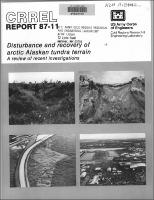Please use this identifier to cite or link to this item:
https://hdl.handle.net/11681/9030| Title: | Disturbance and recovery of Arctic Alaskan tundra terrain: A review of recent investigations |
| Authors: | United States. Environmental Protection Agency United States. Department of Energy Geological Survey (U.S.) U.S. Fish and Wildlife Service Walker, D. A. (Donald A.) Cate, David Wallace, 1952- Brown, Jerry, 1936- Racine, Charles H. |
| Keywords: | Alaska Permafrost Arctic tundra Tundra Tundra ecology Environmental disturbances EPOLAR |
| Publisher: | Cold Regions Research and Engineering Laboratory (U.S.) Engineer Research and Development Center (U.S.) |
| Series/Report no.: | CRREL report ; 87-11. |
| Description: | CRREL Report Abstract: This document is a summary of over a decade of CRREL-managed research regarding disturbance and recovery in northern Alaska. Much of this research was sponsored by the U.S. Geological Survey's National Petroleum Reserve-Alaska exploration program and the Department of Energy's environmental research program, although numerous other agencies and members of the oil industry have also made contributions to several of the university participants. This work comes at a time of major transition in the focus of northern Alaskan environmental research from single-impact studies to analysis of cumulative impacts. Thus, it summarizes studies of anthropogenic disturbances in northern Alaska and discusses the immediate need for new methods to approach the problems of revegetation, restoration and cumulative impacts of terrain underlain by permafrost. This heritage of research comes from many research sites in northern Alaska, including Cape Thompson, the Seward Peninsula, Barrow, Fish Creek, Oumalik, East Oumalik, Prudhoe Bay, the Arctic National Wildlife Refuge and along the trans-Alaska pipeline. The impacts that are discussed include bladed trails, off-road vehicle trails, winter trails, ice roads, gravel pads and roads, borrow pits, roadside impoundments, road dust, hydrocarbon spills and seawater spills. The themes that are emphasized in this report are the following: • Most anthropogenic disturbances have natural analogs, which can provide much inexpensive information that can be related to modern disturbances and their rates of recovery. • Most single-event disturbances will heal and develop a functioning ecosystem within a human life span, but a return to the original ecosystem can rarely be expected for major impacts. • The concept of recovery must be based on consistent terminology that recognizes the distinction between ecosystem resistance (the ability to withstand impact) and resilience (the ability to return to the previous undisturbed state) and also the distinction between complete recovery (a return to the original ecosystem) and functional recovery (the development of a functional ecosystem different from the original). • In permafrost regions with massive ground ice, recovery of the vegetation is limited by alterations to the permafrost regime. Synergistic and multiple-factor impacts are an increasing concern because of the likelihood of the development of additional oil fields across the North Slope and adjacent offshore regions. Research is needed regarding methods of assessing, predicting and mitigating cumulative impacts. Recommendations are presented for future directions in environmental research on arctic Alaskan terrain. |
| Rights: | Approved for public release; distribution is unlimited. |
| URI: | http://hdl.handle.net/11681/9030 |
| Appears in Collections: | CRREL Report |
Files in This Item:
| File | Description | Size | Format | |
|---|---|---|---|---|
| CRREL-87-11.pdf | 6.02 MB | Adobe PDF |  View/Open |